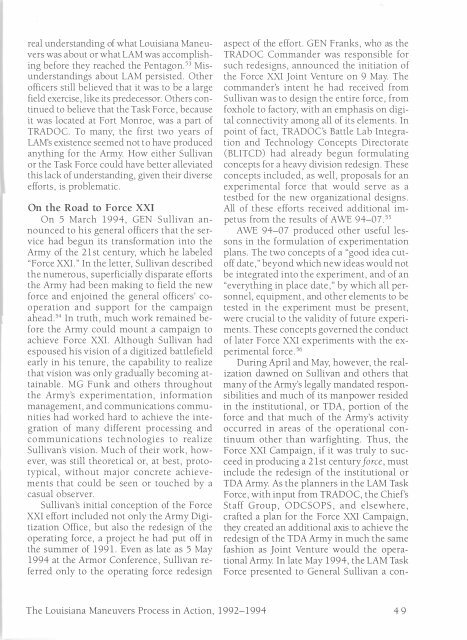The Modern Louisiana Maneuvers - US Army Center Of Military History
The Modern Louisiana Maneuvers - US Army Center Of Military History
The Modern Louisiana Maneuvers - US Army Center Of Military History
Create successful ePaper yourself
Turn your PDF publications into a flip-book with our unique Google optimized e-Paper software.
eal understanding of what <strong>Louisiana</strong> <strong>Maneuvers</strong><br />
was about or what LAM was accomplishing<br />
before they reached the Pentagon. 53 Misunderstandings<br />
about LAM persisted. Other<br />
officers still believed that it was to be a large<br />
field exercise, like its predecessor. Others continued<br />
to believe that the Task Force, because<br />
it was located at Fort Monroe, was a part of<br />
TRADOC. To many, the first two years of<br />
LAM's existence seemed not to have produced<br />
anything for the <strong>Army</strong>. How either Sullivan<br />
or the Task Force could have better alleviated<br />
this lack of understanding, given their diverse<br />
efforts, is problematic.<br />
On the Road to Force XXI<br />
On 5 March 1994, GEN Sullivan announced<br />
to his general officers that the service<br />
had begun its transformation into the<br />
<strong>Army</strong> of the 21st century, which he labeled<br />
"Force XXI." In the letter, Sullivan described<br />
the numerous, superficially disparate efforts<br />
the <strong>Army</strong> had been making to field the new<br />
force and enjoined the general officers' cooperation<br />
and support for the campaign<br />
ahead.54 In truth, much work remained before<br />
the <strong>Army</strong> could mount a campaign to<br />
achieve Force XXI. Although Sullivan had<br />
espoused his vision of a digitized battlefield<br />
early in his tenure, the capability to realize<br />
that vision was only gradually becoming attainable.<br />
MG Funk and others throughout<br />
the <strong>Army</strong>'s experimentation, information<br />
management, and communications communities<br />
had worked hard to achieve the integration<br />
of many different processing and<br />
communications technologies to realize<br />
Sullivan's vision. Much of their work, however,<br />
was still theoretical or, at best, prototypical,<br />
without major concrete achievements<br />
that could be seen or touched by a<br />
casual observer.<br />
Sullivan's initial conception of the Force<br />
XXI effort included not only the <strong>Army</strong> Digitization<br />
<strong>Of</strong>fice, but also the redesign of the<br />
operating force, a proj ect he had put off in<br />
the summer of 1991. Even as late as 5 May<br />
1994 at the Armor Conference, Sullivan referred<br />
only to the operating force redesign<br />
aspect of the effort. GEN Franks, who as the<br />
TRADOC Commander was responsible for<br />
such redesigns, announced the initiation of<br />
the Force XXI Joint Venture on 9 May. <strong>The</strong><br />
commander's intent he had received from<br />
Sullivan was to design the entire force, from<br />
foxhole to factory, with an emphasis on digital<br />
connectivity among all of its elements. In<br />
point of fact, TRADOC's Battle Lab Integration<br />
and Technology Concepts Directorate<br />
(BLITCD) had already begun formulating<br />
concepts for a heavy division redesign. <strong>The</strong>se<br />
concepts included, as well, proposals for an<br />
experimental force that would serve as a<br />
testbed for the new organizational deSigns.<br />
All of these efforts received additional impetus<br />
from the results of AWE 94-07 55<br />
AWE 94-07 produced other useful lessons<br />
in the formulation of experimentation<br />
plans. <strong>The</strong> two concepts of a "good idea cutoff<br />
date," beyond which new ideas would not<br />
be integrated into the experiment, and of an<br />
"everything in place date," by which all personnel,<br />
equipment, and other elements to be<br />
tested in the experiment must be present,<br />
were crucial to the validity of future experiments.<br />
<strong>The</strong>se concepts governed the conduct<br />
of later Force XXI experiments with the experimental<br />
force. 56<br />
During April and May, however, the realization<br />
dawned on Sullivan and others that<br />
many of the <strong>Army</strong>'s legally mandated responsibilities<br />
and much of its manpower resided<br />
in the institutional, or TDA, portion of the<br />
force and that much of the <strong>Army</strong>'s activity<br />
occurred in areas of the operational continuum<br />
other than warfighting. Thus, the<br />
Force XXI Campaign, if it was truly to succeed<br />
in producing a 21st century force, must<br />
include the redesign of the institutional or<br />
TDA <strong>Army</strong>. As the planners in the LAM Task<br />
Force, with input from TRADOC, the Chief's<br />
Staff Group, ODCSOPS, and elsewhere,<br />
crafted a plan for the Force XXI Campaign ,<br />
they created an additional axis to achieve the<br />
redesign of the TDA <strong>Army</strong> in much the same<br />
fashion as Joint Venture would the operational<br />
<strong>Army</strong>. In late May 1994, the LAM Task<br />
Force presented to General Sullivan a con-<br />
<strong>The</strong> <strong>Louisiana</strong> <strong>Maneuvers</strong> Process in Action, 1992-1994 49
















